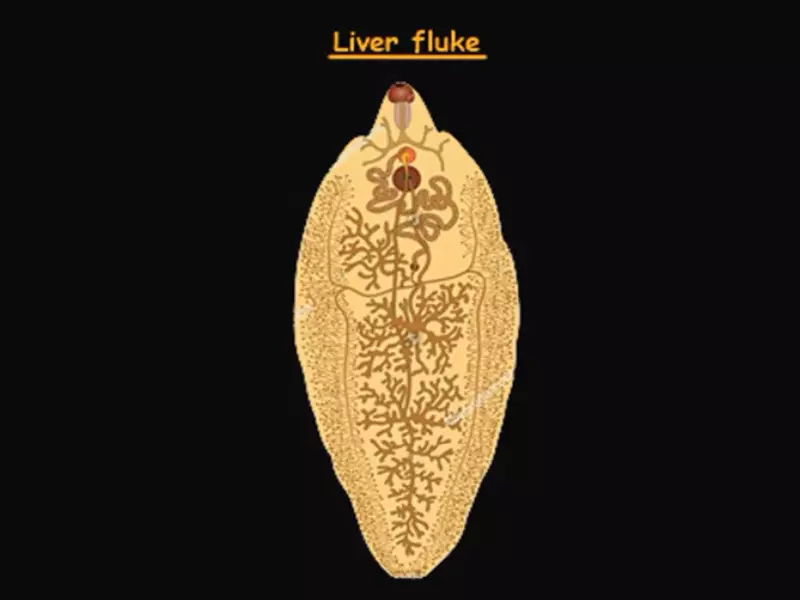Parasitic worms, a topic often shrouded in discomfort, play a significant role in global health issues, affecting both humans and animals alike. Among the myriad of parasites, flukes and tapeworms stand out due to their unique characteristics, life cycles, and the diseases they cause. Their presence across various regions highlights the importance of understanding these parasites for effective prevention and treatment strategies.
Flukes and tapeworms are distinct types of parasitic worms; flukes, belonging to the class Trematoda, are flatworms that primarily inhabit the liver, lungs, and blood, while tapeworms, or Cestoda, are segmented worms residing in the intestinal tract. The primary difference between these parasites lies in their shape, lifecycle, and the diseases they cause, making it crucial for health professionals to identify them accurately for effective treatment.
The impact of these parasites on health cannot be understated, with both capable of causing significant disease and discomfort. Flukes are responsible for conditions such as schistosomiasis and liver fluke infections, while tapeworms can lead to diseases like taeniasis and cysticercosis. Understanding their transmission, lifecycle, and symptoms is essential for preventing and managing infections, underscoring the need for public awareness and education on these parasitic threats.

Flukes Overview
Definition and Characteristics
Flukes, scientifically known as Trematoda, are a class of parasites that belong to the phylum Platyhelminthes. These creatures are flatworms, characterized by their flat, leaf-shaped bodies that allow them to attach to the insides of their hosts. Flukes undergo a complex life cycle involving multiple hosts, including humans, livestock, and various aquatic organisms. They are distinguished by their suckers, which they use to adhere to host tissues, and their ability to reproduce both sexually and asexually, depending on the stage of their life cycle.
Habitat and Transmission
Flukes are adept at finding hosts and can thrive in a variety of environments. Their habitat largely depends on the specific fluke species and their lifecycle requirements. Generally, flukes require aquatic or moist environments for at least one stage of their life. Transmission to humans and animals typically occurs through the ingestion of contaminated water, eating undercooked infected fish or plants, or direct contact with contaminated water bodies. Certain flukes are also capable of penetrating the skin directly. The diversity in their habitats and transmission methods highlights the adaptability of flukes and their capacity to infect hosts in various ways.
Health Impact
Flukes are responsible for several diseases in humans and animals, collectively known as trematodiases. In humans, the most common diseases include schistosomiasis, caused by blood flukes, and fascioliasis, caused by liver flukes. Symptoms can vary widely, ranging from mild abdominal discomfort and diarrhea to more severe conditions such as liver damage, bile duct infection, and chronic illness. In animals, fluke infections can lead to weight loss, reduced fertility, and even death, significantly impacting livestock health and agricultural productivity.
Tapeworms Overview
Definition and Characteristics
Tapeworms, or Cestoda, are another class of parasitic flatworms. Unlike flukes, tapeworms are characterized by their long, ribbon-like bodies, which can grow to several meters in length in some species. Tapeworms consist of a head, or scolex, equipped with hooks and suckers for attaching to the intestinal walls of their hosts, and a series of segments called proglottids, which contain reproductive organs. Tapeworms are unique in that they absorb nutrients directly through their skin from the host’s intestine, where they reside.
Habitat and Transmission
The transmission of tapeworms to humans and animals typically occurs through the ingestion of tapeworm eggs or larvae present in undercooked meat or fish. The lifecycle of a tapeworm can involve one or more intermediate hosts, usually livestock or fish, before reaching maturity in the definitive host. Humans become infected by eating undercooked infected meat, which allows the tapeworm larvae to develop into adult tapeworms in the intestines. Proper cooking of meat and fish is a critical control measure to prevent tapeworm infections.
Health Impact
Tapeworm infections can lead to a range of health impacts, depending on the species and the severity of the infection. In humans, a common condition caused by tapeworms is taeniasis, which may result in mild symptoms like abdominal pain and nausea. However, some tapeworm species can cause more serious conditions, such as cysticercosis, where tapeworm larvae invade tissues outside the intestines, leading to serious complications. In animals, tapeworm infections can cause nutritional deficiencies, intestinal blockages, and reduced growth rates.
Key Differences
Morphology
The most striking difference between flukes and tapeworms lies in their morphology. Flukes are flat and leaf-shaped, with a body that is generally solid, whereas tapeworms have segmented, ribbon-like bodies that can grow much longer. This morphological distinction is crucial for their respective modes of life and reproduction.
Lifecycle and Reproduction
Flukes and tapeworms have distinctly different lifecycles and reproduction methods. Flukes typically require multiple hosts to complete their life cycle, including an aquatic intermediate host. In contrast, tapeworms may only need a single intermediate host before reaching maturity in the definitive host. Additionally, the reproduction process varies, with flukes having complex life cycles involving sexual and asexual reproduction across different hosts, while tapeworms reproduce sexually within the definitive host.
Diseases and Symptoms
The diseases and symptoms caused by flukes and tapeworms also differ. Fluke infections can lead to diseases like schistosomiasis and fascioliasis, with symptoms ranging from digestive issues to severe organ damage. Tapeworm infections, such as taeniasis and cysticercosis, generally cause milder symptoms unless larvae invade tissues outside the intestines, which can be more serious.
Diagnosis and Treatment
Diagnosing and treating infections caused by flukes and tapeworms require different approaches. For diagnosis, medical professionals may look for eggs or larvae in stool samples, blood tests, or imaging for more severe cases. Treatment typically involves antiparasitic medications, but the specific drug and treatment regimen can vary significantly between fluke and tapeworm infections. Understanding the type of parasite is critical for effective treatment and management of these infections.

Prevention Tips
Preventing infections caused by flukes and tapeworms is crucial for maintaining health in humans and animals. Effective prevention involves a combination of personal hygiene, food safety, and environmental measures. These strategies can significantly reduce the risk of infection and the spread of these parasites.
Personal Hygiene
Basic Hygiene Practices
Maintaining good personal hygiene is the first line of defense against parasitic infections. Simple habits can make a big difference:
- Wash your hands thoroughly with soap and water before eating, after using the bathroom, and when handling food. This step is essential in preventing the ingestion of parasites.
- Avoid swimming or wading in bodies of water known to be contaminated with parasites. Skin contact with contaminated water can lead to infections by certain types of flukes.
- Use protective footwear when walking in areas where soil may be contaminated with parasite eggs, especially in regions where sanitation is poor.
Body Care and Cleanliness
Regular body care and cleanliness also play a vital role in preventing parasitic infections:
- Shower regularly, especially after being in potentially contaminated environments.
- Keep nails clean and trimmed to avoid harboring parasite eggs under them.
Food Safety
Safe Food Handling
Proper food handling can prevent the transmission of tapeworms and flukes that are transmitted through contaminated food:
- Wash fruits and vegetables thoroughly before eating, especially if they are to be consumed raw. This step is crucial in removing any microscopic parasite eggs or larvae that might be on the surface.
- Wear gloves if you must handle soil or manure that could be contaminated with parasites, and wash your hands afterward.
Cooking Practices
Cooking food properly is critical in killing parasites that may be present:
- Cook meat and fish to the recommended temperatures. Use a food thermometer to ensure that the internal temperature is high enough to kill parasites.
- Avoid raw or undercooked meat and fish. Dishes like sushi or rare steak carry a higher risk of parasitic infection unless the food has been frozen to kill parasites beforehand.
Environmental Measures
Water Treatment
Safe water is essential for preventing fluke infections:
- Boil or filter water before drinking if you’re unsure about its safety. This is particularly important in areas where water-borne parasites are common.
- Manage waste water effectively to prevent contamination of natural water bodies. Proper sanitation infrastructure reduces the risk of parasite transmission.
Community Health Education
Educating communities about the risks and prevention of parasitic infections can lead to broader public health benefits:
- Conduct awareness campaigns about the importance of hygiene, food safety, and environmental measures in preventing infections.
- Teach children about the importance of handwashing and safe eating habits from a young age.
Environmental Sanitation
Improving environmental sanitation can significantly reduce the prevalence of parasites:
- Implement community-wide sanitation projects to ensure proper disposal of human and animal waste. This helps prevent contamination of soil and water sources.
- Promote the use of latrines and proper sewage treatment facilities in rural and underserved areas.
Livestock and Agriculture Management
Managing livestock and agricultural practices can reduce the risk of tapeworm and fluke transmission:
- Regularly deworm animals to prevent them from becoming sources of parasites.
- Practice crop rotation and other soil management techniques to reduce soil contamination by parasites.
- Avoid using untreated human waste as fertilizer, which can contaminate crops with parasite eggs.
Frequently Asked Questions
What are flukes?
Flukes are a type of parasitic flatworms, scientifically known as Trematodes, that can cause various diseases in humans and animals. They typically infect the liver, blood, or lungs, leading to symptoms like abdominal pain, diarrhea, and in severe cases, liver disease. Flukes are transmitted through contaminated water, undercooked fish, or contact with infected animals.
How do tapeworms infect humans?
Tapeworms infect humans primarily through the ingestion of undercooked or contaminated meat from infected animals. Once inside the human digestive tract, they attach to the intestinal wall, where they grow and segment. Symptoms may include abdominal discomfort, weight loss, and nutritional deficiencies, though many infections remain asymptomatic.
Can flukes and tapeworms be treated effectively?
Yes, both flukes and tapeworms can be treated effectively with antiparasitic medications. Treatment typically involves prescription drugs that target the specific type of parasite. It’s essential for the diagnosis to be accurate for the treatment to be effective. Additionally, preventive measures such as proper food handling and maintaining personal hygiene can significantly reduce the risk of infection.
How can one prevent infection from these parasites?
Preventing infection from these parasites involves several strategies, including boiling or filtering water before drinking, thoroughly cooking meat to safe temperatures, washing hands and maintaining hygiene, especially after handling animals or soil, and avoiding contact with contaminated water sources. Education and public health measures are also crucial in reducing the incidence of these parasitic infections.
Conclusion
The distinction between flukes and tapeworms is not just an academic concern but a crucial aspect of public health and individual well-being. Understanding the differences in their life cycles, transmission modes, and the diseases they cause can significantly impact the prevention, diagnosis, and treatment of these parasitic infections. As we continue to confront these health challenges, the knowledge and strategies shared here play a vital role in safeguarding communities and improving health outcomes worldwide.
In conclusion, the battle against parasitic infections like those caused by flukes and tapeworms requires a combined effort of medical professionals, researchers, and the public. Through increased awareness, education, and adherence to preventive measures, we can mitigate the impact of these parasites. Continued research and development in treatment options further bolster our arsenal against these hidden adversaries, promising a healthier future for all affected populations.
